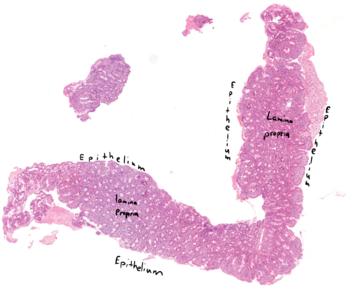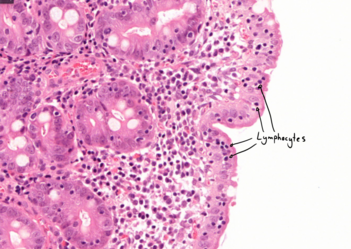3. Coeliac disease – total villus atrophy (Marsh 3c)

Staining: HE
Organ: Duodenum
Description: It’s kind of confusing but both “sides” of the preparation shows the mucosa. This is due to the fixation process.
Only the epithelium mucosae and lamina propria can be seen, no other layers. No villi are visible. There is crypt hyperplasia as the number of crypts is increased compared to normal. Lymphocytes are seen in the epithelium mucosae, showing intraepithelial lymphocytosis.
Diagnosis: Coeliac disease
Causes:
- HLA-DQ2 or HLA-DQ8
Theory:

Coeliac disease, or gluten-sensitive enteropathy is diagnosed based on a biopsy from the duodenum during a gastroscopy.
We use the Marsh classification to determine the severity of the coeliac disease. There are three histological alterations that are seen in coeliac disease:
- Intraepithelial lymphocytosis (presence of lymphocytes among the epithelium)
- Crypt hyperplasia (increased number of crypts)
- Villous atrophy (to which degree the villi are destroyed)
The Marsh classification goes from 1 to 3 and works like this:
- Marsh 1 – Only intraepithelial lymphocytosis is seen
- Marsh 2 – Intraepithelial lymphocytosis and crypt hyperplasia are seen
- Marsh 3 – Intraepithelial lymphocytosis, crypt hyperplasia and villous atrophy are seen
In addition to this is Marsh 3 divided into a, b and c subtypes depending on the severity of the villous atrophy, where c is total villous atrophy. In this slide are areas where there are no evidence of villi, so it’s Marsh 3c.
The Marsh classification originally had a Marsh 4 as well, which included hypoplasia of the small bowel architecture, but the original classification has been revised to only go from 1 – 3.
The number of intestinal crypts (of Lieberkühn) is normally low in the duodenum, however here can we see that crypts are plenty.
